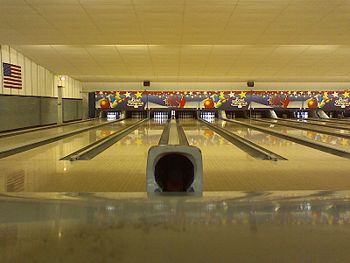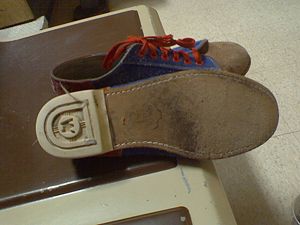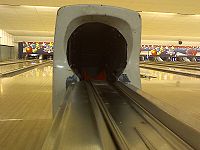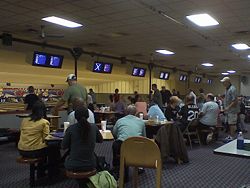Pin bowling
Bowling is an indoor sport in which a player rolls a large, heavy ball down a polished wooden lane to hit a cluster of pins in order to achieve the maximum amount of pin-falls. Most bowlers are competing against others players as each of them attempts to attain the highest number of pin-falls for that particular game.
Terminology
- Alley: the establishment where bowling takes place, the "bowling alley".
- Approach: the method in which a bowler travels from a starting position to the throw line manipulating his or her body in conjunction with the bowling bowl to achieve the greatest possible attempt.
- Bowling ball: a ball typically made of urathane/polyurathane or some other composite plastic, with a specific weight and three holes drilled which are reserved usually for the thumb, middle, and ring fingers.
- Frame: a single round, consisting of two attempts to knock all pins down, with an exception on frame 10.
- Gutter: two channels that lie on either side of the lane that conform to the shape of the bowling ball. Rolling a ball into a gutter results in a score of zero for that attempt and is known as a "gutter ball."
- Lane: the entire distance between the pins and the throw line.
- Pin: a white wooden construct that when knocked down counts as one point.
- Spare: knocking down all 10 pins down in a single frame within two attempts. Designated on a scorecard by the symbol "/"
- Strike: knocking down all 10 pins down in a single frame with one attempt. Designated on a scorecard by the symbol "X"
- Turkey: scoring three strikes in a row.
- 10th frame: the last frame in a single game. The maximum amount of attempts that may occur in frame 10 is three, providing each attempt results in a strike, or if a spare occurs in the first two attempts during this frame, or if a strike is the first ball thrown.
Equipment
Although the primary piece of equipment used by the player is the bowling ball, it is a requirement that players wear special shoes, "bowling shoes", when playing. These shoes are different from regular shoes in that the heel and sole of the shoe are made of specific materials, not only for protection of the lanes (reduce scuffmarks, damage to the wood), but also for the protection of the player as well. The shoes are designed to have a small amount of "slide", because the momentum from releasing the bowling ball transfers to the foot. A shoe with a pure rubber sole provides greater traction and little or no "give" on the lane surface; as a result the increased friction in the material could result in a potential injury.
Some professional bowlers prefer to use a special "bowling glove" or a wrist support that holds the wrist and base of the hand into a specific position that reduces stress incurred from forcing the musculature to remain still during the approach and release. This position is not too dissimilar from that of a handshake.
Additionally, some may also prefer towels and a special talc that keeps the bowling ball drill holes free from moisture and lane grease, and reduces the friction of the release, allowing the fingers to slide out of the holes more easily at the release.
Objective
The objective of the game is to maximize the possible amount of pins one may score throughout the frames.
Rules
Bowling out of any other physical sport may possibly have the fewest rules in terms of how the game is played. Any method may be used to get the bowling ball from the throw line to the pins, which offers a great amount of flexibility. However, a bowler may not cross the throw line; doing so results in a fault or "error" and forfeits any points made in that frame. Additionally, if a ball knocks down any pins after recoiling out of the gutter, those points will be invalidated and the frame may be lost.
Scoring
There is a system for scoring pins in bowling. Any number of pins knocked down in a single frame count for their face value, except if all pins are knocked down in the first attempt. This is registered as a strike. If the remaining pins are knocked down in the second attempt, it is registered as a spare.
Scoring a strike or a spare incurs an additional bonus on the next frame. A strike will accrue additional points in the frame it was scored in based on the next two successive throws. A space will accrue additional points in the frame based on the very next successive throw. These bonuses do stack with successive frames.
Scoring a spare
| Template:Bowlingscoresheet | Template:Bowlingscoresheet | Template:Bowlingscoresheet | Template:Bowlingscoresheet |
In Frame three, John scores a spare. In the very next roll in frame four, he only rolls a one. Normally, 7+2+6+1+9+1 = 26. However, the next roll following the spare (first roll, frame four) is accounted into that frame (frame three). The total for frame three is 7+2+6+1+9+1+1 = 27.
Scoring a strike
| Template:Bowlingscoresheet | Template:Bowlingscoresheet | Template:Bowlingscoresheet | Template:Bowlingscoresheet |
In this example, Susan rolls a strike in frame two. Since a strike counts the next two successive throws, the two rolls from frame three are accounted for in frame two, 3+0+10+2+2=17.
Scoring a spare in every frame gives a total score of 150. Scoring a strike in every frame yields a total possible score of 300, otherwise known as a "perfect game".
In this example, scoring a mark in frame ten allows you one additional roll.
Mechanics
Most scoring today is done by a computer system that mostly eliminates the need for hand-calculation. However manual scoring may be required when the computer system fails to score the pinfall correctly.
In almost all alleys, there is an element of mechanical failure that can occur in the pinsetting (the device which places the pins is called the "pinsetter") and ball return (a series of belts, ramps, and other machinery that collects the ball after the roll and returns it to the player after each roll) machinery. Two primary systems exist to supplement the implied smooth operation of this system: the "reset" button, and an individual responsible for mechanical corrections who works behind the lanes.[1] An often-displayed error on the scoring terminals is "Please Cycle Pinsetter", which is the result of the computerized pinsetting equipment attempting to self-correct.
Community
Regular or professional bowlers are often a pretty tight-knit group, by virtue of leagues that can be very competitive and offer a social environment. Many leagues have specific criteria for who may join: some leagues are women or men-only, some are mixed, and some are divided up by age group. There are many different offerings hosted at alleys. These leagues typically require dues to be paid on a schedule which go toward rewards and trophies at the end of league play, or sometimes toward the manufacture of coordinated bowling shirts for the team.
Additionally, there are some aspects of common curteousy that are usually followed among bowlers; allowing a person in an adjacent lane to complete their roll before you begin yours is an unwritten rule usually followed in league play.
Dining
Most bowling establishments serve food and usually have a license to sell beer and wine. The type of food you should expect when going to a bowling alley are mostly grill-style items: hamburgers, fries, salad, hot dogs, wraps, onion rings, etc.
References
- ↑ Smith, Patrick; Thomas, Aaron (photos) (December 2006). "Experience: Pinhead". ethos magazine 58 (2). Retrieved on 2007-10-05.





